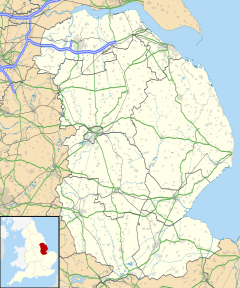Winterton, Lincolnshire facts for kids
Quick facts for kids Winterton |
|
|---|---|
| Town | |
 All Saints' Church, Winterton |
|
| Population | 4,765 (2021 Census) |
| OS grid reference | SE926185 |
| • London | 150 mi (240 km) SSE |
| Unitary authority | |
| Ceremonial county | |
| Region | |
| Country | England |
| Sovereign state | United Kingdom |
| Post town | SCUNTHORPE |
| Postcode district | DN15 |
| Dialling code | 01724 |
| Police | Humberside |
| Fire | Humberside |
| Ambulance | East Midlands |
| EU Parliament | Yorkshire and the Humber |
| UK Parliament |
|
| Website | www.wintertoncouncil.co.uk |
Winterton is a small market town and civil parish in North Lincolnshire, England. It is about 5 kilometers (3 miles) north-east of Scunthorpe. In 2021, about 4,765 people lived in Winterton.
The town is close to the Humber river. You can even see the Humber Bridge from many parts of Winterton. As of 2022, the leader of the town council, called the mayor, is Marilynne Harrison.
Contents
A Look Back in Time: Winterton's History
Winterton has a very long history, going all the way back to Roman times. People have found many interesting Roman things here, including large mosaic floors.
The Mystery of the Winterton Lady
In October 1968, workers were making the A1077 wider. They found a huge stone coffin! Inside was a skeleton of a young woman. She was between 20 and 25 years old and about 1.6 meters (5 feet 3 inches) tall.
This woman was very important. Her coffin was made from a single block of limestone. She was also laid on a sheet of lead. Down the hill from where she was found are the remains of a Roman villa. This villa is famous for its beautiful mosaic floors. It's very likely she lived there.
How Winterton Got Its Name
The name Winterton probably comes from "Winter" or "Wintra." This was the name of an early king of Lindsey. The town's location near the Humber river was important. It was a good place for people to settle in the Lindsey area.
The Old Railway Line
Winterton used to have a railway station. It was part of the North Lindsey Light Railway. This railway connected the town to Scunthorpe and Winteringham. The old station is now closed and not used anymore. It was located between Winterton and the nearby village of Thealby.
The Winterton Agricultural Show
The Winterton Agricultural Society started in 1872. Its goal was to help farmers in the area. For many years, the society held a two-day Agricultural Show. It also had sports events in the town.
Today, the show is still a big event. It takes up more than 20 acres of land. The society now owns this land. This helps them have enough space for all the shops, games, and fun activities.
The show celebrates farming and countryside life. It brings together people from both the town and nearby areas. It has many different events that appeal to everyone. Because of this, it is very popular. More than twelve thousand people from all over the region come to visit the show.
Famous People from Winterton
Winterton has been home to some interesting people:
- Wallace Sargent – He was a very important astronomer. He used to be the director of the Palomar Observatory. He also taught at the California Institute of Technology. He was born nearby and went to Winterton Primary School.
- Neville Tong – A well-known cyclist.
- William Fowler – (1761–1832) He was an artist, architect, and builder.
Winterton's Twin Town
Since 1993, Winterton has been twinned with Saffré in France. This means the two towns have a special friendship and connection.
See also
 In Spanish: Winterton para niños
In Spanish: Winterton para niños




